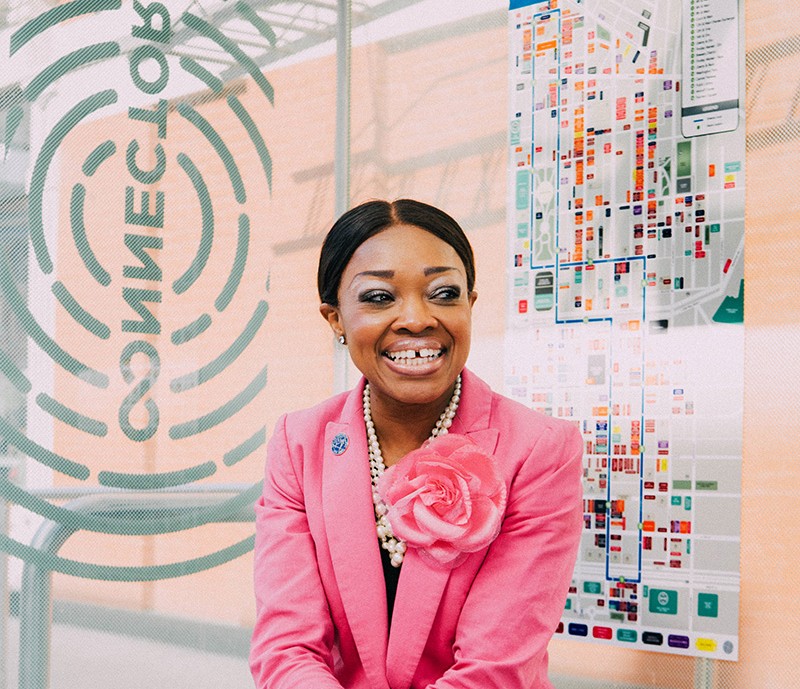Sami Reed, CityBeat
April 5, 2023
Cincinnati is one of 23 (and counting) urban cities across North America that have publicly committed to reducing energy consumption, water use and transportation emissions by at least 50% before scientists say it’s too late
This story is featured in CityBeat’s April 5 print edition.
The number of eco-minded businesses – from plant-based delis to secondhand clothing stores to zero-waste refilleries – is growing in Cincinnati. These establishments make it easy (and, for some, fun) for consumers to reduce their carbon footprints.
But what about the region’s sustainability efforts behind closed doors, when direct profit isn’t even in the equation?
A member of the 2030 Districts Network, Cincinnati is one of 23 (and counting) urban cities across North America that have publicly committed to reducing energy consumption, water use and transportation emissions by at least 50% before scientists say it’s too late. According to the United Nations Intergovernmental Panel on Climate Change, 2030 is the year that “unprecedented” action would need to take place to mitigate the worst impacts of climate change.
The Cincinnati district features a group of 49 member organizations that include breweries, museums and universities, all pledging to do their part. The group’s 18 founding members, like Cincinnati’s government and the Cincinnati Zoo, collectively are committing more than 7 million square feet to the district.
So why aren’t Cincinnati’s climate efforts common knowledge?
“I think other parts of the world acknowledge our climate progress more than Cincinnatians do,” Ollie Kroner, director of Cincinnati’s office of environment and sustainability, tells CityBeat.
In a February story in The Guardian, Cincinnati is noted as one of the global cities using Panorama, a national climate action plan tool designed to connect climate action to financing and ultimately to turn ideas into a plausible course of action.
This is just the tip of the iceberg regarding the city’s current efforts, Kroner says.
“We are laser-focused on the climate crisis: how it will impact city government, how it will impact the quality of life of the people that live here and what we’re gonna do about it,” Kroner says.
A new green plan
The latest iteration of the Green Cincinnati Plan is slated to be revealed this spring. Spearheaded by the city’s office of environment and sustainability, it’s an all-encompassing environment plan for the city that has been reimagined and updated every five years since 2008.
“The Green Cincinnati Plan is an action plan. It analyzes where all our carbon emissions come from and then presents a strategy to move toward carbon neutrality by 2050,” Kroner says. “Cincinnati was actually among the early U.S. cities to adopt climate action back in 2008, so we have some practice of this.”
This will be the fourth iteration of the plan, updating on a five-year rhythm.
“As you might imagine, the science keeps improving; politics evolve; the technology we have available to think about continues to progress,” Kroner says, noting that carbon neutrality is a big goal.
According to the Green Cincinnati Plan, committing to carbon neutrality is a goal, but in the fight for climate justice, the environment isn’t the only factor. In partnership with Groundwork Ohio River Valley and Green Umbrella, two esteemed sustainability allies, Cincinnati’s office of environment and sustainability has created a climate equity indicators report that looks at 55 different metrics, helping the office understand how the climate crisis plays out differently from one community to the next. The data collected from this report reveals how some communities are more vulnerable than others.
“We had some funding to actually pay members from that community to come forward and treat them as the subject matter experts on their community and the way that climate is impacting them,” Kroner says. “As our data improves, we are able to zoom in at the city level, zoom in at the neighborhood level, we’re starting to zoom in at the block level – and when you have that kind of data paired with the lived experience of our community members, you can develop real-world practical solutions.”
Kroner says the climate conversation can’t exist without considering those who are affected by it.
“Our steering committee embraced an equity commitment acknowledging inequities [that] government has helped drive historically, addressing those and committing to community voice in the process,” Kroner says.
Leading this steering committee is Cincinnati City Council member Meeka Owens. In kickstarting the Green Cincinnati Plan refresh, Owens says the framework has revolved around sustainability, resilience and equity.
Owens and other officials kicked off the Green Cincinnati Plan’s refresh last May, and 42 community engagement events took place shortly after. Since then, 50 out of Cincinnati’s 52 neighborhoods have held feedback sessions.
“We are doing the work of continually getting this message out there and really focusing on communities that have not been a part of the climate conversation and being really intentional there,” Owens says.
Feedback gathered from the sessions was woven into a draft of a cohesive action plan that the public then reviewed and commented on in January and February. Residents provided more than 600 comments, and Owens and the office of environment and sustainability now are integrating that feedback into a final plan to be unveiled later in April.
Kroner says residents can expect to see a focus on housing in the Green Cincinnati Plan.
“Housing is a loud theme from the community. Why would I care about climate when I’m being evicted next week?” Kroner says. “Designing programs to help reduce utility costs, specifically for people who are renting, is one of our core focuses.”
Kroner says he anticipates a major challenge ahead.
“All of the climate models show that we need to begin to electrify everything. What can we do to help encourage or incentivize the move to electric homes that can be powered by clean renewable energy?” he asks.
The plan also prioritizes transportation.
“About a third of our emissions in Cincinnati come from transportation,” Kroner says. “We’ve just passed this momentous bus study, so we have funding to really make major improvements. What can we do as a city to maximize those [state] dollars and encourage development along transit corridors to help connect communities, help reduce that transportation carbon footprint?”
Kroner says that to accomplish the goal of a greener Cincinnati, climate change must be approached from its effects on the environment and the people living in it. It’s a transition that could take decades, but it’s an opportunity he feels must be maximized now.
“We really feel like this is our moment. We have strong leadership from the mayor-council, we have tremendous community support, and the federal government is making funding available in a way that we’ve never seen before. In some ways, the stars are aligning right now and we feel like we have to make the most of this window of opportunity.”
Cincinnati’s local climate challenges
Some experts assert that a human health perspective is important when studying climate change. That’s what Susan Pinney, the director of the University of Cincinnati’s Center for Environmental Genetics, is doing.
“We feel we’re one of the best-kept secrets of Cincinnati,” Pinney tells CityBeat. “The focus is research on the health effects of environmental exposures.”
Cincinnati faces a number of climate challenges, Pinney says, adding that addressing how these issues affect residents’ health is crucial for the researchers at the Center for Environmental Genetics. She says there are two significant weather events exacerbated by climate change on her radar: floods and tornadoes.
“Floods can actually stir up waste deposits along the river, and we especially worry about the Ohio River. Floods can also cause mold in homes, which is a huge health problem,” Pinney says, noting that with the high traction brought in by activities like boating and kayaking, it’s imperative for the Ohio River to be safe.
After experiencing a flooding disaster in her own home in New Richmond, Pinney says she understands first-hand how time-consuming and costly it can be to repair a flooded home and actually rid it of all debris, from the carpet to the walls.
“People who don’t have a whole lot of resources can’t do that. Although the visible mold may be gone, there is mold that is invisible and they’re living with that the rest of their lives and the health effects of that,” Pinney says, adding that her team at UC is working to change that.
With climate trends and their deviations vital in helping inform future decisions at the Center for Environmental Genetics, Pinney notes that the characteristics of tornadoes have begun to shift.
“Data seems to suggest the number of tornadoes has not changed throughout the years, but what has changed is the power of the tornado – the intensity of these tornadoes – and where they’re located,” Pinney says, mentioning tornado touchdowns in irregular locations like Philadelphia in recent years. “What are the airborne exposures that are created by a tornado?” We wanna get into that. A tornado comes around, buildings are demolished and such, houses have asbestos in them, they have metals like lead in the paint, and now it’s in the environment.“
Pinney says she especially is concerned about the rain that follows a tornado.
“Things get saturated. Buildings that have been damaged but are still standing, [they] don’t have a roof and get saturated with rain, and then later on they end up with mold,” Pinney says.
Pinney’s department is able to carry out its mission through its partnership with the National Institute of Environmental Health Science, which provides necessary funding.
”It’s money to improve our capacity to do research, by improving our labs, by improving the expertise of our scientists, by encouraging young faculty, giving them some salary support so they can build their research program.”
Pinney notes the department’s recent work on air pollution.
“We’ve got around the problem of school buses idling while they’re waiting to pick up kids – that’s an example of something that research drove the change and then members of the general public insisted on the change, and so that’s made a substantial change in exposures to kids.”
Pinney says it’s important to her to make Cincinnati’s air and water safer.
“If we’re encouraging people to use our bike trails, to use our walking trails, to run in marathons here, we really have to pay attention to our air quality,“ she says. “In clean air, people can participate more in sports. In clean air, we have more fun.”
Looking to the future
Studying and teaching net-zero energy building at the University of Cincinnati and its College of Design, Architecture, Art, and Planning, Anton Harfmann designs homes to be energy efficient from layout to materials to appliances. To help combat climate change, he combines his architectural engineering background with design.
“Architectural engineering is that middle ground between the very creative side of architecture and the very practical side of engineering and tries to bridge that chasm between ideas and materials,” Harfmann says.
Harfmann studies and teaches net-zero energy building – designing homes to be energy efficient from layout to materials to appliances. According to the U.S. Department of Energy, residential and commercial buildings account for 40% of all U.S. energy consumption. Putting his expertise and passion into practice, Harfmann has turned his 1834 farmhouse into somewhat of a lab, challenging himself with converting it into a net-zero residence while preserving its historic charm.
His architecture and engineering students were able to visit this “lab” to gain hands-on learning, helping them prepare for future net-zero projects and, ultimately, do this work on a much larger scale in the community, Harfmann says.
“Teaching this next generation, I have 50 voices now that are out there clamoring for this kind of stuff and who understand it and are able to then move forward with it on their own, as opposed to me doing one thing right. I can do my house, but that’s only one,” Harfmann says.
Harfmann says there’s a difference between greening up older and newer homes, though.
“The older homes are really difficult to solve this energy equation on,” Harfmann says. “New construction, it’s not as difficult because we have double-pane or triple-pane windows with low emissivity coatings and argon filled in between, and they’re extremely efficient compared to single-pane glass that is 170 years old.”
While building new has its eco advantages, Harfmann acknowledges that not everyone has the resources to do so. In fact, he says that using buildings that already exist in Cincinnati can be the most energy-efficient option, so he was determined to prove that a sustainable old home was possible.
“The idea is to match energy being consumed with energy being produced. If we can bring the energy consumption down as far as we possibly can, then that’s less we have to produce,” Harfmann says. “With the 1834 farmhouse, the problem is there’s only so much you can do in terms of energy consumption before you hit a brick wall – literally, because the walls there are just two or three [layers] with some brick.”
Harfmann says he even found horsehair that was sprinkled into the plaster, which was used to prevent cracking as it expands and contracts.
To make this older home more energy efficient, Harfmann started with LED bulbs and insulated where he could before moving on to the windows.
“There were no storm windows when I moved in, so now suddenly I have two panes of glass and a little bit of air space, which helped tremendously. The windows are your weakest spot,” Harfmann says. “The windows are your weakest spot.” Harfmann says he patched the gaping holes and insulated his windows, reducing the amount of energy flowing through the walls, coming in from the summer heat or escaping the winter.
Harfmann notes while many individuals are interested in making the switch to renewable energy options like solar, they often don’t see it as a good financial investment. To him, that’s a flawed model. While paying off a solar array could take years, Harfmann claims that adopters still save more in a year than they’d be accumulating in interest from money sitting in a savings account.
“If you rethink, when will it pay off and think alternatively, how much interest am I making every year? How much am I not paying in utilities? This is tax-free income, and it’s immune to future energy cost rises,” Harfmann says.
“The incentives that they’ve put out to insulate your home, buy better appliances, get storm windows, get a better water heater, buy an induction stove, buy an electric car are all there,” Harfmann continues, noting that the federal Inflation Reduction Act offers a rebate of up to $14K per household for converting to sustainable energy options.
Back in City Hall, council member Meeka Owens says she believes that no effort is too small in the fight against climate change.
“We’ll start at the micro level because it’s important that we’re all doing our part – are we recycling? Are we avoiding tonnage to the landfill by doing so? Are we composting?” Owens asks.
Over at the office of environment and sustainability, director Oliver Kroner is working on large-scale changes throughout the community and agrees that everyone has an important role in addressing the climate crisis.
“I think a lot of people think corporations are causing climate change and they point at corporations as the responsible party. Corporations definitely play a role, but absolutely individuals do also,” Kroner says.
He urges individuals to consider the environmental impact of their day-to-day lives, from their purchases to their food.
“Those small daily choices do accumulate in a very major way, and I think that we need to own that as individuals and make the right choices, and the organizations we’re a part of will follow suit,” Kroner says. “Behavior is contagious, so leading by example is where we need to be.”
Follow us: Google News | NewsBreak | Reddit | Instagram | Facebook | Twitter


